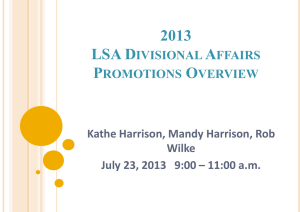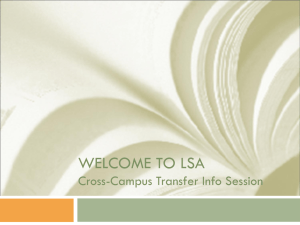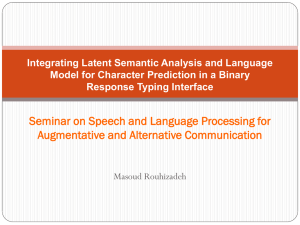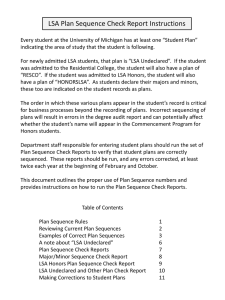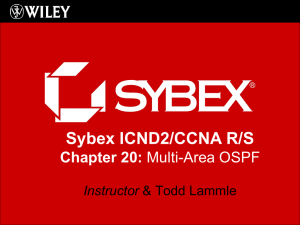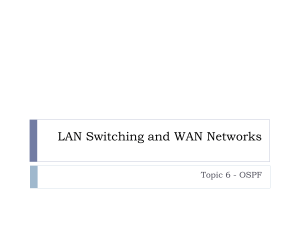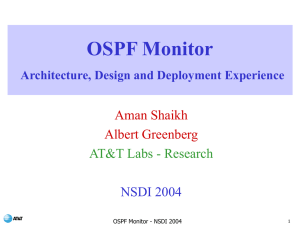Open Shortest Path First (OSPF) - J-Net Community
advertisement
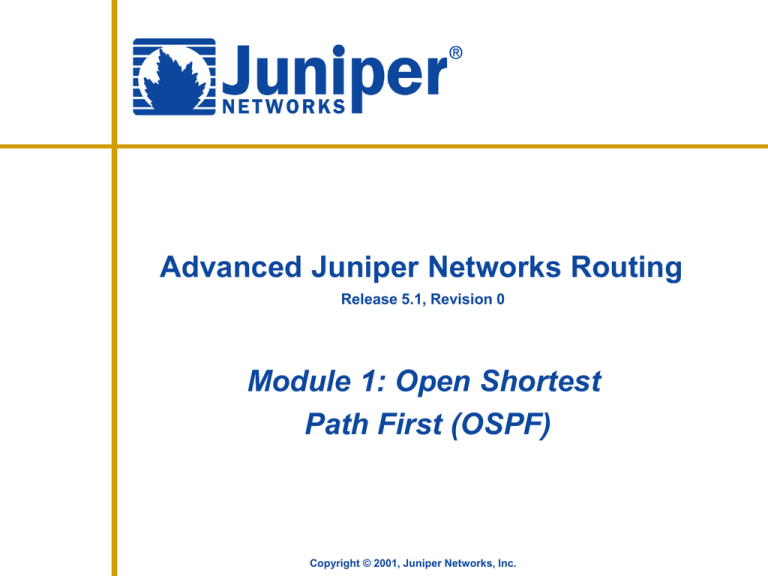
Advanced Juniper Networks Routing
Release 5.1, Revision 0
Module 1: Open Shortest
Path First (OSPF)
Copyright © 2001, Juniper Networks, Inc.
Module Objectives
Review the basic components of the OSPF Protocol
Discuss the OSPF neighbor hello protocol and
adjacency formation process
Examine the function of the Link-State Database
(LSDB) and how it contributes routes to the routing
table
Look at the different kinds of OSPF packet types
Configure OSPF on a Juniper Networks router
Copyright © 2001, Juniper Networks, Inc.
Link-State Update Packets
Carry one or more link-state advertisements
Link-state update packets consist of:
– OSPF header
– (4-byte) Number of advertisements
– Link-state advertisements
Field length,
in bytes
1
1
Version
Type
number
# of LSAs
2
4
Packet
length
Router ID
LSA
Header
4
Area ID
LSA Data
2
2
8
Variable
Checksum
Authentication
type
Authentication
Data
LSA
Header
LSA Data
Copyright © 2001, Juniper Networks, Inc.
…
LSA Packet Types
Link-state advertisement packet types:
–
–
–
–
–
–
–
–
Router LSAs - Type 1
Network LSAs - Type 2
Summary LSAs - Types 3 and 4
AS external LSAs - Type 5
Group membership LSAs - Type 6
NSSA LSAs - Type 7
External attributes LSAs - Type 8
Opaque LSAs - Types 9, 10, and 11
Each LSA type describes a portion of the OSPF routing
domain
Types 6, 8, 9, and 11 are not supported
Copyright © 2001, Juniper Networks, Inc.
LSA Packet Header
Information to uniquely identify the LSA
The 20-byte LSA header consists of:
– (2-byte) LS Age
– (1-byte) Options
– (1-byte) LS Type
– (4-byte) Link-State ID
– (4-byte) Advertising Router
– (4-byte) LS Sequence Number
– (2-byte) LS Checksum
– (2-byte) Length
Copyright © 2001, Juniper Networks, Inc.
Router LSA (Type 1)
Originated by each router in an area
Describes the state and cost of the router’s interfaces
Router LSAs consist of LSA header plus:
– (1-byte) Five 0 bits followed by the V, E and B bits
– (1-byte) 0 bits
– (2-byte) Number of Links
– (4-byte) Link ID
– (4-byte) Link Data
– (1-byte) Link Type
– (1-byte) Number of TOS Metrics
– (2-byte) Metric
– (4-byte) Additional TOS Data
Copyright © 2001, Juniper Networks, Inc.
Router LSA Example
user@host> show ospf database router extensive
OSPF link state database, area 0.0.0.0
Type
ID
Adv Rtr
Seq
Age Opt
Router *192.168.16.1
192.168.16.1
0x80000004
947 0x2
bits 0x3, link count 3
id 192.168.24.1, data 10.222.28.1, type PointToPoint (1)
TOS count 0, TOS 0 metric 1
id 10.222.28.0, data 255.255.255.0, type Stub (3)
TOS count 0, TOS 0 metric 1
id 192.168.16.1, data 255.255.255.255, type Stub (3)
TOS count 0, TOS 0 metric 0
Gen timer 00:30:56
Aging timer 00:44:13
Installed 00:15:47 ago, expires in 00:44:13, sent 00:15:47 ago
Ours
Copyright © 2001, Juniper Networks, Inc.
Cksum Len
0xd45b 60
Network LSA (Type 2)
Originated by designated routers (DR)
Describes all routers attached to a network segment
Network LSAs consist of LSA header plus:
– (4-byte) Network Mask
– (4-byte) Attached Router
Copyright © 2001, Juniper Networks, Inc.
Network LSA Example
user@host> show ospf database network extensive
OSPF link state database, area 0.0.0.0
area 0.0.0.1
Type
ID
Adv Rtr
Seq
Age Opt Cksum Len
Network 10.222.1.1
192.168.20.1
0x80000002
813 0x2 0x6876 32
mask 255.255.255.0
attached router 192.168.20.1
attached router 192.168.40.1
Aging timer 00:46:27
Installed 00:13:32 ago, expires in 00:46:27, sent 1w5d 01:07:09 ago
Copyright © 2001, Juniper Networks, Inc.
Summary LSA (Type 3)
Originated by area border routers (ABR)
Describes all routers attached to a multiaccess
segment
Summary LSA (Type 3) consists of LSA header plus:
– (4-byte) Network Mask
– (1-byte) 0 bits
– (3-byte) Metric
– (1-byte) TOS
– (3-byte) TOS Metric
Copyright © 2001, Juniper Networks, Inc.
Summary LSA Example
user@host> show ospf database netsummary extensive
OSPF link state database, area 0.0.0.0
Type
ID
Adv Rtr
Seq
Age Opt
Summary 10.222.44.0
192.168.36.1
0x80000004 1011 0x2
mask 255.255.255.0
TOS 0x0, metric 1
Aging timer 00:43:08
Installed 00:16:49 ago, expires in 00:43:09, sent 1w5d 01:08:42
Summary 192.168.32.1
192.168.36.1
0x80000001 1355 0x2
mask 255.255.255.255
TOS 0x0, metric 1
Aging timer 00:37:25
Installed 00:22:33 ago, expires in 00:37:25, sent 1w5d 01:08:42
Summary *192.168.40.1
192.168.16.1
0x80000001 1527 0x2
mask 255.255.255.255
TOS 0x0, metric 2
Gen timer 00:14:18
Aging timer 00:34:33
Installed 00:25:27 ago, expires in 00:34:33, sent 00:25:27 ago
Ours
Copyright © 2001, Juniper Networks, Inc.
Cksum Len
0x8530 28
ago
0x49f9
28
ago
0x87c6
28
Summary LSA (Type 4)
Originated by area border router (ABR)
Describes the destination of an ASBR
Summary LSA (Type 4) consists of LSA header plus:
– (4-byte) Network Mask
– (1-byte) 0 bits
– (3-byte) Metric
– (1-byte) TOS
– (3-byte) TOS Metric
Copyright © 2001, Juniper Networks, Inc.
ASBR Summary LSA Example
user@host> show ospf database asbrsummary extensive
OSPF link state database, area 0.0.0.0
Type
ID
Adv Rtr
Seq
Age Opt
ASBRSum *192.168.20.1
192.168.16.1
0x80000003
76 0x2
mask 0.0.0.0
TOS 0x0, metric 1
Gen timer 00:48:43
Aging timer 00:58:43
Installed 00:01:16 ago, expires in 00:58:44, sent 00:01:16 ago
Ours
ASBRSum 192.168.32.1
192.168.36.1
0x80000001 1477 0x2
mask 0.0.0.0
TOS 0x0, metric 1
Aging timer 00:35:22
Installed 00:24:35 ago, expires in 00:35:23, sent 1w5d 01:10:44
ASBRSum *192.168.40.1
192.168.16.1
0x80000001 1649 0x2
mask 0.0.0.0
TOS 0x0, metric 2
Gen timer 00:14:36
Aging timer 00:32:30
Installed 00:27:29 ago, expires in 00:32:31, sent 00:27:29 ago
Ours
Copyright © 2001, Juniper Networks, Inc.
Cksum Len
0x4818 28
0x3b07
28
ago
0x79d3
28
AS External LSA (Type 5)
Originated by AS boundary routers (ASBR)
Describes destination external to the OSPF network
Two types of external destinations (Type 1 external and
Type 2 external)
AS external LSAs consist of LSA header plus:
– (4-byte) Network Mask
– E-bit (0 = Type 1 external; 1 = Type 2 external) followed by
–
–
–
–
seven 0 bits
(3-byte) Metric
(4-byte) Forwarding Address
(4-byte) External Route Tag
(4-byte) Optional TOS fields
Copyright © 2001, Juniper Networks, Inc.
External LSA Example
user@host> show ospf database extern extensive
OSPF external link state database
Type
ID
Adv Rtr
Seq
Age
Extern *192.168.17.0
192.168.16.1
0x80000001 1919
mask 255.255.255.0
Type 1, TOS 0x0, metric 20, fwd addr 0.0.0.0, tag 0.0.0.0
Gen timer 00:00:32
Aging timer 00:28:01
Installed 00:31:59 ago, expires in 00:28:01, sent 00:31:58
Ours
Extern
192.168.33.0
192.168.32.1
0x80000001 1878
mask 255.255.255.0
Type 1, TOS 0x0, metric 20, fwd addr 0.0.0.0, tag 0.0.0.0
Aging timer 00:28:42
Installed 00:31:15 ago, expires in 00:28:42, sent 00:31:15
Extern
192.168.37.0
192.168.36.1
0x80000002 1287
mask 255.255.255.0
Type 1, TOS 0x0, metric 20, fwd addr 0.0.0.0, tag 0.0.0.0
Aging timer 00:38:33
Installed 00:21:25 ago, expires in 00:38:33, sent 00:21:25
Extern
192.168.41.0
192.168.40.1
0x80000001 1708
mask 255.255.255.0
Type 1, TOS 0x0, metric 20, fwd addr 0.0.0.0, tag 0.0.0.0
Aging timer 00:31:34
Installed 00:28:25 ago, expires in 00:31:32, sent 00:28:25
Copyright © 2001, Juniper Networks, Inc.
Opt
0x2
Cksum Len
0x3812 36
ago
0x2
0x1713
36
ago
0x2
0xcc54
36
ago
0x2
0x8693
36
ago
NSSA External LSA (Type 7)
Similar to AS external LSAs, but NSSA LSAs have only
area flooding scope
Selectively translated into AS external LSAs (Type 5) at
the NSSA border
N/P bit in the Type-7-LSA’s option field indicates
whether the Type-7-LSA should be translated
– N/P = 1 translate (propagate)
– N/P = 0 do not translate
Copyright © 2001, Juniper Networks, Inc.
NSSA LSA Example
user@host> show ospf database nssa extensive
OSPF link state database, area 0.0.0.0
area 0.0.0.2
Type
ID
Adv Rtr
Seq
Age Opt Cksum Len
NSSA
192.168.33.0
192.168.32.1
0x80000003 1639 0x8 0x7c19 36
mask 255.255.255.0
Type 1, TOS 0x0, metric 20, fwd addr 192.168.32.1, tag 0.0.0.0
Aging timer 00:32:47
Installed 00:27:12 ago, expires in 00:32:41, sent 1w5d 01:13:35 ago
Copyright © 2001, Juniper Networks, Inc.
Opaque LSA (Types 9 – 11)
Allows for the future extensibility of OSPF
Opaque LSAs consist of a standard LSA header
followed by application-specific information
The information field can be used directly by OSPF or
by other applications
Consists of a standard LSA header followed by a 32-bit
application-specific information field
The difference is in flooding scope
Type 10 are used for MPLS Traffic Engineering
Types 9 and 11 are not currently supported
Copyright © 2001, Juniper Networks, Inc.
Sample OSPF Database
user@host> show ospf database
OSPF link state database, area 0.0.0.1
Type
ID
Adv Rtr
Router *192.168.16.1
192.168.16.1
Router
192.168.20.1
192.168.20.1
Router
192.168.40.1
192.168.40.1
Network 10.222.1.1
192.168.20.1
Summary *10.222.4.0
192.168.16.1
Summary *10.222.28.0
192.168.16.1
Summary *10.222.44.0
192.168.16.1
Summary *192.168.24.1
192.168.16.1
Summary *192.168.32.1
192.168.16.1
Summary *192.168.36.1
192.168.16.1
ASBRSum *192.168.24.1
192.168.16.1
ASBRSum *192.168.32.1
192.168.16.1
ASBRSum *192.168.36.1
192.168.16.1
OSPF external link state database
Type
ID
Adv Rtr
Extern *192.168.17.0
192.168.16.1
Extern
192.168.21.0
192.168.20.1
Extern
192.168.25.0
192.168.24.1
Extern
192.168.33.0
192.168.36.1
Extern
192.168.37.0
192.168.36.1
Extern
192.168.41.0
192.168.40.1
Seq
0x80000009
0x8000000f
0x80000004
0x80000007
0x80000005
0x80000005
0x80000005
0x80000005
0x80000003
0x80000005
0x80000004
0x80000003
0x80000004
Age
2489
296
47
596
2186
2044
1744
1444
1285
1144
685
544
385
Opt
0x2
0x2
0x2
0x2
0x2
0x2
0x2
0x2
0x2
0x2
0x2
0x2
0x2
Cksum Len
0xc864 60
0x3bfd 72
0xd3db 48
0x5e7b 32
0xd31c 28
0xc018 28
0x24a2 28
0x2635 28
0xe56d 28
0xaba2 28
0x1a41 28
0xd77a 28
0x9fae 28
Seq
0x80000004
0x80000007
0x80000002
0x80000001
0x80000004
0x80000002
Age
85
896
2911
2298
822
2725
Opt
0x2
0x2
0x2
0x2
0x2
0x2
Cksum Len
0x3215 36
0xe358 36
0xa593 36
0x520
36
0xc856 36
0x8494 36
Copyright © 2001, Juniper Networks, Inc.
LSA Flooding Scopes
Area 0
LSA 1
Area 0
LSA 2
Area 1
LSA 2
Area 0
Area 0
LSA 3
LSA 4
Area 2
Area 3
LSA 3
LSA 4
Area 3
Area 0
LSA 3
LSA 5
Area 3
LSA 5
Area 1
External
Routes
Area 0
LSA 5
Area 3
LSA 5
Area 1
LSA 3
Area 1
LSA 1
Backbone
(0.0.0.0)
Area 2
LSA 3
Area 3 Area 3
LSA 3 LSA 4
Area 2
LSA 1
Area 3
LSA 1
Area 3
LSA 2
Area 0
Area 0
LSA 3
LSA 4
Area 1
Area 0
LSA 3
LSA 5
Area 2
LSA 3
Area 3
LSA 5
Area 2
LSA 2
Area 0
LSA 3
Area 1
LSA 3
Area 3
LSA 3
Area 0
LSA 4
Area 3
LSA 4
Area 0
LSA 5
Area 3
LSA 5
Area 2
External
Routes
Copyright © 2001, Juniper Networks, Inc.
Area 3
OSPF Router-ID
Each OSPF router selects a 32-bit value to use as its
Router-ID
The Router-ID is populated within the LSAs that each
router sends out
– The link-state database uses this information for run the SPF
algorithm
When RPD initiates, the primary interface of the router
is chosen as the Router-ID
A value can be permanently set within [edit
routing-options]
[edit routing-options]
user@host# set router-id 192.168.1.1
Copyright © 2001, Juniper Networks, Inc.
OSPF Cost
Cost, or metric, of an interface indicates the overhead
required to send packets out a particular interface
Default OSPF cost for all links is 10**8/bandwidth (bps)
All links with a bandwidth greater than 100M will have
a cost of 1
– Cost calculation results in a value <1, so it is rounded
Cost can be set on a per interface basis
[edit protocols ospf]
user@host# show
area 0.0.0.0 {
interface so-0/0/0.0 {
metric 12;
}
interface at-1/0/1.100 {
metric 73;
}
}
Copyright © 2001, Juniper Networks, Inc.
Reference Bandwidth
The 10**8 value in the cost calculation can be changed
– Automatically alters the cost of interfaces
– Allows for a consistent change across all interfaces
Use the reference-bandwidth command within
[edit protocols ospf]
[edit protocols ospf]
user@host# set reference-bandwidth 1g
[edit protocols ospf]
user@host# show
reference-bandwidth 1g;
area 0.0.0.0 {
interface so-0/0/0.0 {
metric 12;
}
interface at-1/0/1.100;
}
Copyright © 2001, Juniper Networks, Inc.
Effects of Altering Metrics
Metric values are advertised in Type 1 or Type 2 LSAs
and populate link-state database
As each router runs SPF algorithm, each LSA is
examined individually for cost of outgoing interface
– That cost is used in the final metric calculation
Routers can disagree about the cost on a network link
– HongKong sees a cost of 45 to reach Amsterdam
– Amsterdam sees a cost of 60 to reach HongKong
5
HongKong
15
10
SanJose
20
Montreal
Copyright © 2001, Juniper Networks, Inc.
25
30
Amsterdam
OSPF Authentication
Authentication occurs within an individual area
– Three types are supported: none, simple, and MD5
By default, the authentication type is set to none
– Effectively means no authentication is performed
A plain-text password is used with type simple
Each interface requires an authentication key
– Multiple interfaces can use the same key
– Keys are always encrypted in the configuration
[edit protocols ospf]
user@host# show
area 0.0.0.2 {
authentication-type simple;
interface ge-0/0/0.0 {
authentication-key "$9$-TbwgPfzn6A";
}
}
Copyright © 2001, Juniper Networks, Inc.
MD5 Authentication
Includes an encrypted checksum with all packets
– Provides better security than type simple
Each interface requires an authentication key
– Multiple interfaces can use the same key
– Keys are always encrypted in the configuration
Each key requires a key-id value
– If omitted, a value of 1 is used
[edit protocols ospf]
user@host# show
area 0.0.0.1 {
authentication-type md5;
interface so-0/3/1.0 {
authentication-key "$9$ul8b0IcyrvL7VKM" key-id 10;
}
}
Copyright © 2001, Juniper Networks, Inc.
Virtual Links
Virtual links can connect remote OSPF areas together
Often used for an area not physically connected to the
backbone
– Can also be used for a discontiguous backbone
Configuration always occurs within area 0.0.0.0
– Creates a virtual ABR out of the remote router
– “Tunnels” packets through a transit area
Both ends must configure the link towards each other
Virtual Link
Area 0
Area 1
Copyright © 2001, Juniper Networks, Inc.
Area 2
Virtual Link Configuration
The area to be “tunneled” through is the transit-area
The router at the far end of the link is the neighbor-id
– This is the 32-bit router ID
Once configured, the virtual link appears as an
operational OSPF interface
[edit protocols ospf]
user@host# show
area 0.0.0.1 {
interface fe-0/2/2.0;
}
area 0.0.0.0 {
virtual-link neighbor-id 192.168.0.1 transit-area 0.0.0.1;
}
[edit protocols ospf]
user@host# show ospf interface
Interface
State
Area
vl-192.168.0.1
PtToPt
0.0.0.0
[edit protocols ospf]
user@host# show ospf neighbor
Address
Interface
10.222.10.1
vl-192.168.8.1
DR ID
0.0.0.0
State
Full
ID
192.168.0.1
Copyright © 2001, Juniper Networks, Inc.
BDR ID
0.0.0.0
Pri
Nbrs
1
Dead
0
39
Overload Bit
Used to advertise information to neighbors, but not be
used for transit traffic
– Sets metrics to 65535 on all transit links
Can be set permanently or with a timeout value
– Timer is between 60 and 1800 seconds
– Timer only runs after RPD starts
[edit protocols ospf]
user@host# show
overload;
area 0.0.0.0 {
interface so-0/0/0.0;
interface ge-0/1/0.0;
}
user@host> show ospf database router extensive
OSPF link state database, area 0.0.0.3
Type
ID
Adv Rtr
Seq
Age
Router
192.168.56.1
192.168.56.1
0x80000005
71
id 192.168.48.1, data 10.222.61.1, type PointToPoint (1)
TOS count 0, TOS 0 metric 65535
Copyright © 2001, Juniper Networks, Inc.
Opt
0x2
Cksum Len
0x540b 60
Multi-Area OSPF Configuration
Configured at the [edit protocols] hierarchy level
List each interface and area separately
protocols {
ospf {
area <area-id> {
interface <interface-name>;
interface <interface-name>;
interface <interface-name>;
}
area <area-id> {
interface <interface-name>;
}
area <area-id> {
interface <interface-name>;
}
}
}
Copyright © 2001, Juniper Networks, Inc.
Review Questions
Copyright © 2001, Juniper Networks, Inc.

